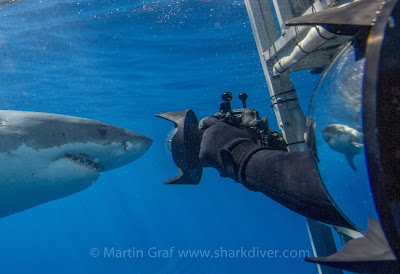Get to know “Scarboard” Great White Shark at Guadalupe Island

“Scarboard” is another one of my favorite sharks. You’re probably beginning to see a pattern here. I have a lot of “favorite” sharks. It’s is amazing how all these sharks have different behaviors. Some are a bit skiddish, others are seemingly relaxed without a care in the world. Observing them for 16 years, I have grown attached to these guys and girls. However, as I always point out, I absolutely love these sharks, I’m crazy about them, but it is NOT a mutual feeling. As much as some people want you to believe that they just want to be hugged, they really don’t. They are awesome predators, not out to get us, but they are not harmless pets either.
| “Scarboard” |
Scarboard is a massive female shark, one of our biggest at Guadalupe Island at around 19′. When we first met her in 2002, she was already huge. Like most of our adult females, she shows up at Guadalupe Island every other year. After getting mating at Guadalupe, she is spending the year in between offshore, before giving birth off the coast of Baja or in the Sea of Cortez. She doesn’t have any mutilations, like “Lucy” and so many others, but she does have a very unique characteristic that makes identifying her easy. She has a very distinct line from her nose halfway to her dorsal fin. Where most Great White Sharks‘ lines have a continuous curve, Scarboard’s is straight.
| “Scarboard” |
After we first encountered her in 2002, she came back in 04 and 06, but then we didn’t see her again until 2011. We don’t know, if we simply didn’t see her, or if she stayed away from Guadalupe for 5 years.
When we don’t see a shark during the season we expect to see them, we always worry that something might have happened to them. Luckily, sometimes, like in Scarboard’s case, we worry about nothing. Where do they go during that extended time away from the Island, what do they do? There is so much we don’t know about those sharks.
The first time we saw Scarboard, after her 5 year absence, I was in the middle of our 2 cages, she slowly swam by the first cage, checking out each individual diver and when she came to me, she looked me straight into the eyes, stopped and did a 180 degree turn, looked at me again, swam off, turned and swam back at me, stopped again, turned and swam off. It looks like that she recognized me, even after a 5 year absence.
Last season “Scarboard” was being used for protection by some bait fish. I’ve never seen anything like that before. When she swam by, she looked like the “Bearded Lady”.
| Scarboard the “Bearded Lady” |
A lot of people are surprised to learn that Great White Sharks recognize individual divers. The fact that they do is not as strange as it seems. We know of lots of fish that recognize divers. Groupers that have a favorite individual they follow around, moray eels that come out of their holes when they recognize a diver, Wolf eels that wrap themselves around the neck of an individual etc. It’s important to remember though, just because White Sharks recognize individual divers, doesn’t mean that they “love” us, want to be petted, or have any feelings towards us. We need to respect them for what they are, amazing predators, neither mindless killers, nor harmless pets.
For me there is nothing quite like seeing a familiar shark and realize it recognizes me as well. It still amazes me that we keep seeing the same individuals on a regular basis. They migrate thousands of miles, but come right back to the same spot.
If you want to find our for yourself what it’s like to come face to face with a great white shark and want to learn how to identify these sharks, join us on one of our “science” expeditions. We do have some spaces open and would love to introduce you to our sharks.
Call 619.887.4275, email crew@sharkdiver.com or visit www.sharkdiver.com for more information.
Let’s go shark diving!
Cheers,
Martin Graf
CEO Shark Diver
About Shark Diver. As a global leader in commercial shark diving and conservation initiatives Shark Diver has spent the past decade engaged for sharks around the world. Our blog highlights all aspects of both of these dynamic and shifting worlds. You can reach us directly at staff@sharkdiver.com.

